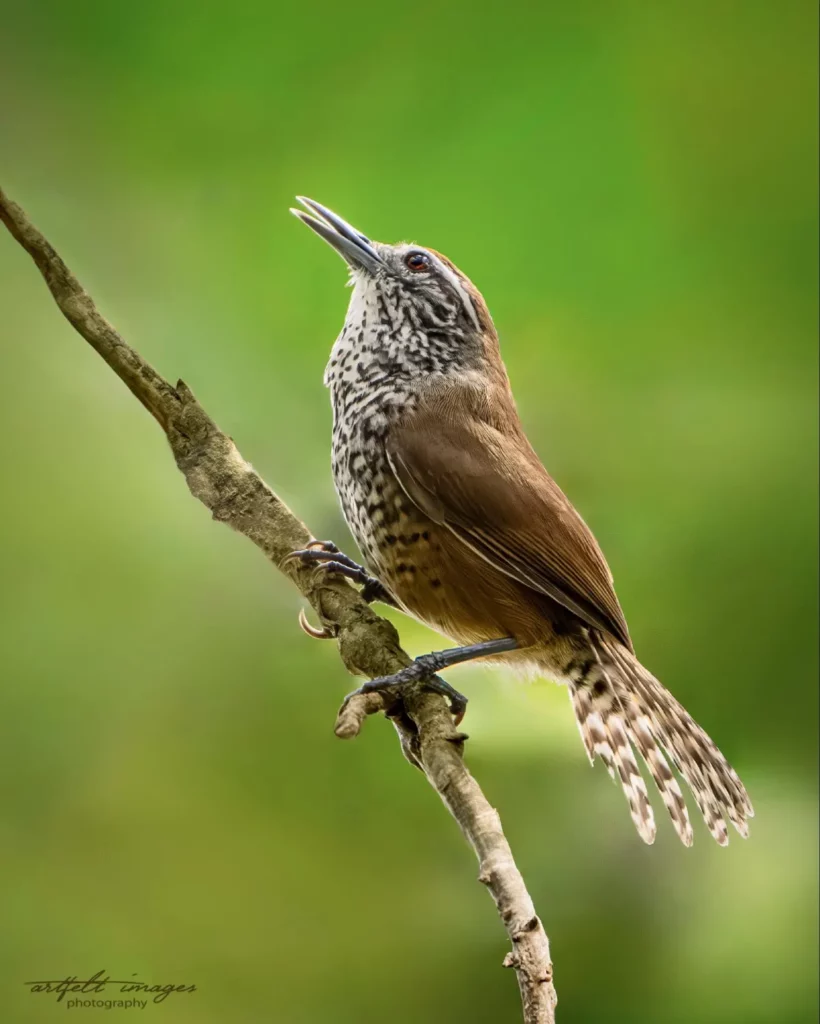Spot-Breasted Wren

Pheugopedius maculipectus
Scientific Name
Troglodytidae (Wrens)
Family
Passeriformes
Order
There are no widely recognized subspecies.
Subspecies.
Range and Habitat
Geographic Range
Found in Central America, primarily from southern Mexico through Belize, Guatemala, Honduras, Nicaragua, and into Costa Rica.
Migratory Patterns
The Spot-Breasted Wren is non-migratory and generally remains within its tropical range.
Preferred Habitat
Prefers dense undergrowth in tropical and subtropical forests, secondary forests, and plantations. It is also commonly found near human habitations in gardens and thickets.
Altitude Range
Typically found at low to mid-elevation, up to 1,500 meters.
Costa Rica Habitat
In Costa Rica, Guanacaste Province, particularly in Santa Rosa National Park and surrounding dry forests, is an excellent place to spot this species. It can also be found in dense underbrush in gardens and secondary forests near towns.
Conservation Status
Least Concern
Conservation Status
Population Status
The population is considered stable across its range, with no significant declines reported.
Habitat destruction due to deforestation and agricultural expansion. However, the Spot-Breasted Wren adapts well to secondary forests and disturbed habitats.
Conservation efforts
No specific conservation programs for this species, but it benefits from the protection of its habitats in national parks and reserves.
Primary Threats
Habitat destruction due to deforestation and agricultural expansion. However, the Spot-Breasted Wren adapts well to secondary forests and disturbed habitats.
Identification
Spot-Breasted Wren
Rarity Level:
CommonBest Viewing Times:
Early Morning (Dawn - 8 AM), Afternoon (2 PM - 5 PM)
Size
Approximately 14-15 cm (5.5-6 in) in length.
Plumage
The Spot-Breasted Wren is noted for its warm brown upperparts, contrasted with a heavily spotted white breast. The face has a distinct pale eyebrow, and the flanks are a warm, rusty color.
Distinctive Features
Its speckled breast pattern and white eyebrows make it easy to distinguish. The short, slightly decurved beak is typical of wrens.
Sexual Dimorphism
There is little to no sexual dimorphism; males and females appear similar.
Diet and Feeding Behavior
Primary Diet
- Mainly insectivorous, feeding on spiders, caterpillars, and other small invertebrates. It will occasionally eat small fruits or berries.
Foraging Techniques
- The Spot-Breasted Wren often forages near the ground or in dense vegetation, hopping through branches and foliage while flicking its wings.
Feeding Times
- Active throughout the day, with peak activity in the early morning and late afternoon.
Behavior Patterns
Spot-Breasted Wren
Lorem ipsum dolor sit amet, consectetur adipiscing elit, sed do eiusmod tempor incididunt ut labore et dolore magna aliqua.
Social Structure
These birds are generally seen in pairs or small family groups. They are not highly social but will sometimes forage with other small bird species.
Song and Vocalization
The Spot-Breasted Wren has a rich, loud song composed of whistles, trills, and complex melodies. The song is used both for territorial defense and pair bonding.
Courtship and Mating Ritual
The male will sing to attract a mate and may perform displays such as wing flicking.
Territoriality
They are quite territorial, using their loud song to defend their area from other wrens.
Birdwatching Tips
Best Locations
The Spot-Breasted Wren is frequently seen in the northwest, particularly in Guanacaste’s dry forests and regions like Santa Rosa National Park. It also inhabits more humid areas near the Caribbean side. Caño Negro region in Costa Rica offers excellent opportunities to spot the spot-breasted wren, especially during early morning guided tours

Best Time of the Year
The Spot-Breasted Wren can be seen year-round in Costa Rica, with no significant seasonal changes in behavior.
Common Behavior
Listen for their distinctive and melodious song, especially in the early morning. They often stay low in dense vegetation, so scanning bushes and undergrowth is key.
Recommended Gear
A good pair of binoculars with a close focus, as the birds tend to stay near the ground. Bring a bird call app to help recognize their intricate songs.
Breeding and Nesting Behavior
Breeding Season
The breeding season is mainly during the rainy season, from May to August.
Nesting Sites
Nests are dome-shaped, often placed in dense vegetation or low bushes. They are constructed from twigs, grasses, and other plant materials, with a side entrance.
Clutch Size
Typically lays 2-4 eggs
Incubation Period
{acf_breeding_and_nesting_incubation_period}
Parental Care
Both parents participate in feeding the young after they hatch.
Did You Know?
How do I identify this bird?
Look for the combination of a speckled white breast, warm brown upperparts, and a noticeable pale eyebrow. Listen for their loud, intricate songs.
Where is the best place to see it?
In Costa Rica, dry forest areas in Guanacaste are prime locations for sightings.
Is this bird endangered?
No, the Spot-Breasted Wren is currently classified as Least Concern.
Interesting Behaviors
Spot-Breasted Wrens often pair for life and can be seen foraging closely together as a bonded pair.
Cultural Significance
Though not widely known in popular culture, wrens as a family are often symbols of industriousness and hard work in many traditions.